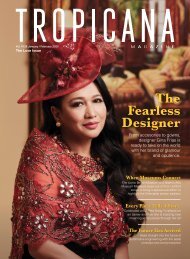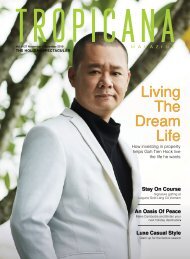Tropicana Magazine Jan-Feb 2018 #116: A Start From The Heart
Start fresh in the year of 2018. Expat Educator Ian Temple shares his own unexpected journey in shaping young minds at Tenby Schools; Check out your Chinese Zodiac for some predictions on fortune; Melbourne's Coolest Bars will blow you mind; all that and more this issue.
Start fresh in the year of 2018. Expat Educator Ian Temple shares his own unexpected journey in shaping young minds at Tenby Schools; Check out your Chinese Zodiac for some predictions on fortune; Melbourne's Coolest Bars will blow you mind; all that and more this issue.
Create successful ePaper yourself
Turn your PDF publications into a flip-book with our unique Google optimized e-Paper software.
FASHION FEATURE<br />
“While the<br />
communist<br />
revolution of 1949<br />
paused the fashion<br />
developments in<br />
China for a while,<br />
refugees brought<br />
their clothing out<br />
of the country.”<br />
<strong>The</strong> common people might choose a flower<br />
symbol. <strong>The</strong> peony – China’s national flower –<br />
symbolises affluence and prosperity; the lotus,<br />
purity and loveliness; the chrysanthemum,<br />
longevity. Fish are also believed to bring<br />
prosperity. All these were common designs for<br />
the material of their garments.<br />
When the qipao became popular in the<br />
south, it was given the name cheongsam which<br />
simply means long dress in Cantonese. <strong>The</strong><br />
qipao/cheongsam migrated south through<br />
China in the 20th century. By the 1920s, it<br />
was popular all over the country. It was also<br />
changing and becoming more like the close<br />
fitting, shorter version we recognize today.<br />
But it always retained the main features of the<br />
high mandarin collar and slitted skirt, and<br />
usually the right side buttoning. In the south,<br />
Shanghai became the cheongsam capital where<br />
fashion designers promoted them and factories<br />
mass-produced them.<br />
While the communist revolution of 1949<br />
paused the fashion developments in China for<br />
a while, refugees brought their clothing out of<br />
the country. <strong>The</strong> style soon became popular<br />
in Hong Kong, Singapore and other Asian<br />
countries, from where it reached Western<br />
fashion designers. Around the modern world,<br />
including in China, versions of the cheongsam<br />
are now worn for high society occasions, for<br />
party-going and for dressed-up events.<br />
<strong>The</strong>y are also often chosen as uniforms to<br />
give an oriental flavor to services or events.<br />
For example, the medal bearers of the 2008<br />
Olympics in Beijing wore them, as did some<br />
of the participating teams in the opening<br />
ceremony. And we would not be surprised to<br />
find those delightful female flight attendants,<br />
on some of the eastern airlines, wearing them<br />
as they check seat belts and serve food and<br />
drink. Nor would we blink at a cheongsam-clad<br />
waitress in a Chinese restaurant anywhere in<br />
the world.<br />
<strong>The</strong> cheongsam is now available in many<br />
different versions and the average woman<br />
can usually find a type that suits her best.<br />
Different kinds of cheongsam can play up your<br />
best features and play down those you’d prefer<br />
to hide.<br />
For example, you can show off your<br />
beautiful shoulders and back with a cheongsam<br />
halter neck collar and low backed dress.<br />
Alternatively, you can choose between<br />
TM | JANUARY/FEBRUARY <strong>2018</strong><br />
72


















